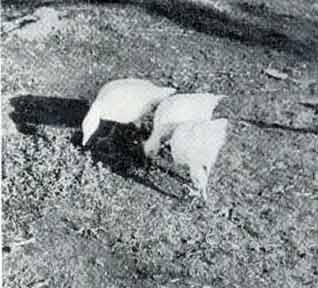Wild Goose Haven, Page 3
By MYRTLE J. BROLEY
Gizzler, as they call him from his peculiar way of eating, follows John about the yard. He even flies out into the fields and stays with him while he ploughs, or cuts the golden grain. Whenever possible he flies up into John's arms, snuggling contentedly against him. Anyone walking around the farm is apt to find Gizzler untying shoe laces, pulling at bits of thread from clothing, or carrying on an intermittent cackling as if holding conversation.
A commotion among the ducks one night sent Joe hurrying out. The "Hoo-hoo" of a great horned owl told him what was wrong. For some nights the silent killer continued his raids, keeping the water fowl in an uproar. Efforts to find its hiding place seemed unavailing, but sharp eyes discovered him sleeping in a maple. A bullet put an end to his marauding.
Much has been learned from studying the birds on the ponds. Almost every spring one or two rare or unusual visitors stop here. The boys tell of a black bird, about the size of a bittern with a curved bill that stayed around for two days. Undoubtedly this was a glossy ibis or black curlew, surprisingly far north.
Last spring a beautiful snow goose stayed at the pond and mated with Gizzler. The blue and snow geese always fly North together but were not known to mate. Four little goslings were hatched safely, two of them exactly like their snow mother while two had the pure white head and throat and dark back of Gizzler.

THREE SNOW GEESE FEEDING
At first the little pied-billed grebes, inimitable little divers, were most welcome but they are heartily disliked now since John found one killing a mallard duckling. He had seen the ten newly-hatched babies, then a few hours later noticed the still warm bodies of four of them. What could have killed them? Returning a little later he saw a grebe striking a duckling repeatedly. By the time he rescued the little fellow it was almost done for.
Perhaps the greatest thrill the boys have had came one April afternoon. A flock of twelve wood ducks, seven beautifully plumed and colored males, landed on the pond. The boys had never seen these lovely creatures before but they knew then from the many pictures they had studied. Through field glasses they admired the purplish crest with it white lines and the drakes greenish-blue heads and the metallic bronzy backs.
"It's hard to tell the colors on them," John said "they change as the light strikes them. Anyway they're the most beautiful birds we've had around here, and so light and graceful on the water!"
Will places such as Gebauer's bring back this dwindling species so that more of us may exult in its beauty? What a blessing if this is so, for the wood duck is becoming a rarity indeed in most places.
Many ducks and geese winter on the Gebauer plan but the greater part of them, even the young birds raised there, migrate south. During the blasts and blizzards of the northern winters, the boys study about their friends, plan how to make their ponds better and safer for them and devise ways and means of feeding the increasing flocks of migrants.
A year ago last fall they were worried because there was so little food left out for the throngs of snow and blue geese, so they left a goodly bit of grain standing on one of their own fields. Although it was quite close to the house the geese cleaned it up thoroughly before the left the first week in May. Then John burned the stubble, ploughed it under, and, in spite of the extremely dry summer, this field returned the best yield of grain on the farm. So Nature paid for the kindness to her feathered children.
"Having the ducks and geese here has been the biggest joy we've had," John told us. "It was fun trying to outwit them in the air and get a good shot, but it's far more fun to have them make friends with you and eat out of your hand; nice to have them nesting around the place, bringing their downy young in here to feed."
"Yes," Joe added, "and to watch the differences them. Lots of them come here wild, and stay. But there's old Sober-sides, that Canada over there. He'll never fly again-wing broken, but every spring he starts walking north. We have to go after him and bring him back or else the wolves would get him. He just cannot seem to get over his desire to return to his old nesting ground."
People from different parts of the country write to ask about the place and about the birds, and many visitors come to see these tame wildfowl. Watching the lovely creatures as they float about on the water, hearing the wild and stirring calls of goose and swan, or the swift beat of wings as a thousand or so birds take to the air, we realize that here is a worthwhile effort indeed, and al¬though it is off the beaten track the world will make a road to the Gebauer gate.
 Printer-friendly version
Printer-friendly version
